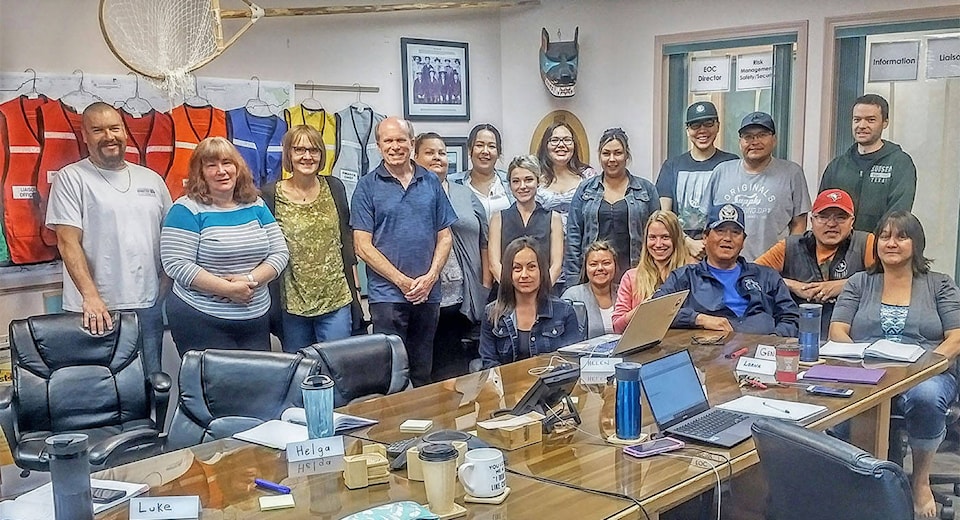Staff working at the Tsilhqot’in National Government recently completed an emergency operations training course.
The goal of the course was to upgrade the emergency operations capacity of the TNG by sharing resources and outfitting an EOC command centre in the TNG catchment area that will lead to self-sufficiency and will expedite emergency response in remote areas.
In February the TNG hired Brian Moore, a retired member of the Kelowna Fire Dept., as its emergency management co-ordinator.
“Part of my job is to co-ordinate training and that was the first formal training we had this year,” Moore told the Tribune.
“We will be doing another two-day course in the near future.”
Similar to other organizations, Moore said when training for an EOC it is easier to train people taking into account their everyday positions.
“It simplifies the training so people aren’t learning something entirely foreign to them,” he explained.
Last year former New Westminster city councillor Chuck Puchmayr arranged to donate a used fire truck and a vehicle to the community of Tl’entiqox First Nation in the spirit of forming a sister city relationship in light of the fact war chief Chief Ahan was most likely buried in New Westminster after being hanged there in 1865.
Read more: First Nations and non-First Nations community forge relationship in spirit of reconciliation
Building on that relationship, Puchmayr canvassed his community for some funding to cover the cost of the emergency operations training and arranged for Bryan Larrabee, who is also a part-time instructor with the Justice Institute of B.C., to teach the two-day course in Williams Lake for the TNG.
Pachmayr said Piva Modern Italian Restaurant, in New Westminster, Alan DeGenova, president of Honour house and Bryan Larrabee (instructor), husband of Chief Rhonda Larrabee of the New Westminster Qayqayt First Nation all made the course possible.
“New Westminster businesses and residents are now playing a roll in reaching out to indigenous communities in the Tsilhqot’in region which will enhance and support the work being undertaken by the New Westminster city council,” Pachmayr said.
Earlier this month, Tsilhqot’in chiefs gathered in New Westminster to commemorate Ahan’s hanging.
Chief Joe Alphonse, tribal chair of the TNG, said the chief was wrongfully hanged and they want his remains returned to his homeland in the Chilcotin region.
During flooding in the Chilcotin earlier in July, Moore said the TNG teamed up with the Cariboo Regional District to operate a joint emergency operations centre.
TNG natural resource rangers were sent out to title lands as rapid damage assessors.
“We stopped at everybody’s places, even the tenure holders, guest ranches, places like that, making sure everyone was OK,” Moore said.
“We have some folks that are at the extreme end of the Taseko Lake Road that got a pretty good beating there at Beece Creek.”
The impacts were minor compared to CRD properties, Moore confirmed.
One home had water in the crawl space and another property had damage to its bridge.
Communication always has been and will be a challenge, Moore said.
“We have some people that are not even on the grid. We are not like a municipality or community that might have a volunteer fire department or first responders,” Moore said. “Our intelligence is really the people that live out there and I’ve got to give them credit. You know what you are getting into when you move way out there, but you become that much more resilient.”
Having a working relationship with the CRD means the lines on the map don’t matter, he added.
“We will work together to get the job done as quick as we can.”
Moore said moving up to the Williams Lake area was the best thing he ever did.
“I was actually retired for minus three hours on Jan. 7 when I got a phone call at 7 a.m. offering me the job,” Moore said.
“I told my wife and hemmed and hawed and then said yes. I have relatives up this way and used to come up here always as a family.”
Moore is a Canadian Navy veteran and was a dispatch supervisor, communications co-ordinator and deputy emergency plan co-ordinator while at the Kelowna Fire Dept.
Read more: Mapping an emergency in the Central Okanagan
news@wltribune.com
Like us on Facebook and follow us on Twitter
